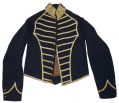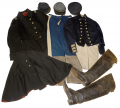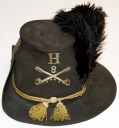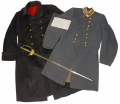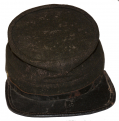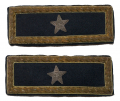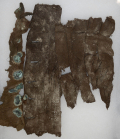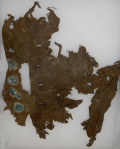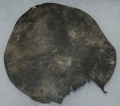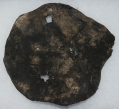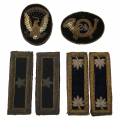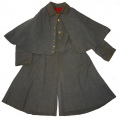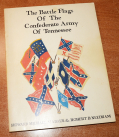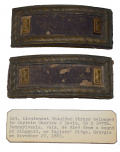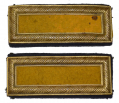site search
online catalog
Uniforms & Cloth
Showing 41 to 60 out of 218
ID’D P1855 MOUNTED SERVICES MUSICIAN’S SHELL JACKET – WILLIAM OSWALD, 4th PENNSYLVANIA CAVALRY
William Oswald resided in Northampton County, Pennsylvania when he enlisted on August 15th, 1861. On that same day, he mustered into Company “A” of the 4th Pennsylvania Cavalry as a Bugler. … (1268-776). Learn More »
CONFEDERATE OFFICER’S UNIFORM GROUP OF LIEUTENANT, CAPTAIN AND MAJOR HUGH MORTIMER NELSON: 1st VA CAVALRY, 6th VA CAVALRY, ADC TO EWELL, WIA GAINES MILL
This wonderful Confederate officer’s grouping came directly out of the family, from the officer’s great-great-grandson in 1995, and went into the collection of esteemed artist, collector and… (153-09). Learn More »
US CAVALRY M1858 DRESS “HARDEE” HAT – 8th REGIMENT, COMPANY H
The M1858 Dress Hat was the formal counterpart to the fatigue duty headwear of the US Army. Made of stiff black felt, the hat found little favor among Civil War servicemen, particularly in the east,… (1268-775). Learn More »
$3,950.00
ON HOLD
ZOUAVE FIRST SERGEANT CHEVRONS
These chevrons measure about 8 inches wide and 4 inches tall and use a red ground with three narrow, sewn, medium blue stripes and a diamond/lozenge, indicating a First Sergeant, the senior… (490-7153). Learn More »
THE HISTORICALLY SIGNIFICANT UNIFORM AND SWORD GROUPING OF BRIGADIER GENERAL EPPA HUNTON CSA
Eppa Hunton was born near Warrenton, Virginia on September 24, 1822. After graduating from the New Baltimore Academy, he taught school for three years, then studied law and was admitted to the bar in… (2025-295). Learn More »
$135,000.00
ON HOLD
SMITH PATENT SECOND LIEUTENANT OF ARTILLERY SHOULDER STRAPS
Military goods dealer James S. Smith of New York patented this form of shoulder strap on June 18, 1861. They used a gilt brass frame stamped to imitate dead and bright bullion embroidered borders and… (142-110). Learn More »
CONFEDERATE DEEP SOUTH DEPOT ENLISTEDMAN'S KEPI
Federal soldier George Wilson, 21st Missouri Infantry (US), captured this cap at the Fort Blakely fight near Mobile, Alabama April 9th, 1865. The cap appears to have been mass produced at a clothing… (2025-300). Learn More »
BRIGADIER GENERAL’S SHOULDER STRAPS
A very nice condition pair of Civil War period Brigadier General’s shoulder straps showing signs of actually having been worn on a uniform. These measure 1-1/2” wide by 3-7/8” long and are… (2025-278). Learn More »
PIECE OF AN INDIAN WAR M1872 FATIGUE BLOUSE FROM FORT PEMBINA, ND
This is a portion of a rare Model 1872 fatigue blouse clearly showing the characteristic pleats of the pattern. These were replacements for the old Civil War M1858 fatigue blouse (the 4-button sack… (1052-579). Learn More »
PIECE OF AN INDIAN WAR M1872 FATIGUE BLOUSE FROM FORT PEMBINA, ND
This is a portion of the rare Model 1872 fatigue blouse. The pattern was a replacement for the old Civil War M1858 fatigue blouse (the 4-button sack coat,) made with the idea of giving the soldier… (1052-578). Learn More »
KEPI OR DRESS CAP STIFFENER FROM FORT PEMBINA
This comes from the excavations at Fort Pembina, ND, a small frontier army post in operation from 1870 to 1895, and is the stiffener from inside the top of a kepi a M1872 dress cap. It is black in… (1052-1152). Learn More »
KEPI OR DRESS CAP STIFFENER FROM FORT PEMBINA
This comes from the excavations at Fort Pembina, ND, a small frontier army post in operation from 1870 to 1895, and is the stiffener from inside the top of a kepi a M1872 dress cap. It is black in… (1052-475). Learn More »
24th MICHIGAN IRON BRIGADE LT. COLONEL MARK FLANIGAN’S HARDEE HAT INSIGNIA WITH HIS LT. COLONEL AND BREVET BRIG. GENERAL SHOULDER STRAPS: WOUNDED AT GETTYSBURG
“Lieutenant-Colonel Flanigan lost his leg in this battle. His conduct here, as everywhere in battle, was gallant and daring.” So wrote Colonel Henry Morrow of the 24th Michigan in his official… (1255-01). Learn More »
INDIAN WARS MOUNTED SERVICES GREATCOAT WITH NEW YORK BUTTONS AND MAKER MARKINGS
This unique military overcoat is of the post-Civil War Indian Wars period and features a unique pattern with New York State appointments. The piece seems to be something of a hybrid between the m1858… (490-7149). Learn More »
BOOK – THE BATTLE FLAGS OF THE CONFEDERATE ARMY OF TENNESSEE
By Howard Madaus & Robert Needham, published by the Milwaukee Public Museum in 1976. Soft cover, perfect bound, 152 pages, 8.5” x 11”. Heavily illustrated with line drawings of which some are… (1266-1055). Learn More »
PAIR OF SMITH PATENT 1ST LIEUTENANT SHOULDER STRAPS ATTRIBUTED TO 147TH PENNSYLVANIA OFFICER
Straps have the usual convex stamped brass false embroidered single border. The surfaces of each have a nice patina. The blue wool rank field has faded to a purple color. One strap has a fair amount… (33-347). Learn More »
$480.00
Originally $650.00
PAIR OF SMITH PATENT 2ND LIEUTENANT OF CAVALRY SHOULDER STRAPS
Straps have the usual Smith patent false embroidered stamped brass border. The yellow wool of the rank field still has strong color but both show light wear. One shows some small moth nips while the… (33-343). Learn More »
$550.00
Originally $750.00
PIECE OF A U.S. FLAG FROM THE FRONTIER US ARMY FORT PEMBINA, NORTH DAKOTA
This piece of bunting comes from excavations at Fort Pembina, ND, conducted on private property with the owner’s permission, a fort established in 1870 by troops of the 20th US Infantry and… (1052-722). Learn More »
PIECE OF CIVIL WAR - INDIAN WAR FRONTIER US ARMY BLANKET FROM FORT PEMBINA, NORTH DAKOTA
This piece of a US Army military issue blanket comes from excavations at Fort Pembina, ND, conducted on private property with the owner’s permission, a fort established in 1870 by troops of the 20th… (1052-615). Learn More »
US ARMY SHIRT CUFF FROM FORT PEMBINA, NORTH DAKOTA
A relic from a small U.S. Army frontier post of the Indian Wars- part of a soldier’s shirt. This is the shirt cuff, still showing a small button near the corner, and a portion of the lower sleeve.… (1052-602). Learn More »
Showing 41 to 60 out of 218
Most Popular
Historical Firearms Stolen From The National Civil War Museum In Harrisburg, Pa »
Theft From Gravesite Of Gen. John Reynolds »
Selection Of Unframed Prints By Don Troiani »
Fine Condition Brass Infantry Bugle Insignia »
British Imported, Confederate Used Bayonet »
Scarce New Model 1865 Sharps Still In Percussion Near Factory New »
featured item
WOUNDED AT GETTYSBURG! 1/6 PLATE AMBROTYPE OF PVT. AURELIUS JAMES DULA, 22ND NORTH CAROLINA
Sixth plate hand-gilt ambrotype. Leatherette case. Anonymous artist. North Carolina. Private Aurelius James “A.J.” Dula (1843 - 1913), a member of Company A (the "Caldwell Rough and Ready Boys”) of the 22nd North Carolina Infantry. A native… (846-577). Learn More »



